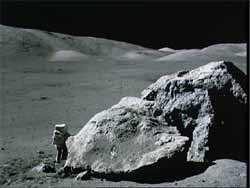Moon exploration race
Entering the 21st century, European countries, America, Japan, India . all have to come up with their Moon exploration plans.
Smart 1 (Photo: Spacetoday)
On November 15, 2004, Smart 1 - Europe's first moon exploration ship entered the Moon's orbit. This is the first space probe in the world to use a solar power system, making use of burning materials 10 times higher than a conventional chemical fuel engine. The goal of Europe's moon exploration is not only limited to conventional engineering and scientific research. They also have plans for 'Aurora' like the new 'space exploration idea' proposed by the United States in 2004 with the ultimate goal of building a base on the moon, and a springboard for implementing the exploration. people go to Mars.
Germany's main aerospace research agency called for: by 2015 set a large telescope, broadcasting long on the moon, taking a step further exploring the mysterious universe, deploying the study of the moon and a residential science research station.
Asia currently has three countries, Japan, China and India, actively implementing moon exploration.
Japan is the third country to successfully launch the 'Non-natural' moon probe. In January 1990, Japan took the lead in breaking the American and Soviet Soviet cornering. The 182kg heavy probe is used to explore the ground environment - the moon's orbit. In 1993, the ship Phi Thien landed on the moon, finishing work. Japan is a resource-poor country so it is very focused on moon exploration. They still hope to have a position in exploring the moon, so they soon set out to build a base on the moon.
On February 25, 2004, China (China) announced: China's moon exploration project was officially named as 'Hang Nga Project'. Currently, China is studying the construction of the Chang'an 1 moon detector using a three-axis stabilization method to orient the moon. The plan was launched in 2007, operating on a circular polar orbit at an altitude of 200km from the moon.

Photo on the Moon
The Hang Nga 1 ship can carry out four major scientific objectives, ie to obtain three-dimensional images of the lunar surface; analyzing the content of useful elements on the surface of the moon and characteristics of material distribution; for the first time, measuring radiation on the lunar surface; explore the moon space environment. In particular, the fourth goal is the first time the environment data China obtained outside the earth's static trajectory. Currently, the Hang Nga 1 moon satellite has completed a preliminary design and design plan and is conducting professional experiments. In the future, China also plans to launch grounding equipment and feedback sampling equipment.
Another Asian country, India, also plans to launch a moon probe of the First Row in 2007. This is a satellite flying around the moon conducting research at a height of 100km in space. If the exploration plan is successful for the first time, India plans to explore the moon for the second time in 2015.
Tuyet Nhung ( According to china.com.cn )
- The first race on the Moon may take place next year
- Reveal the image of Europe's Moon exploration ship
- Easy to 'race' up space
- China has started producing Hang Nga 3 ships
- Moon Express Company started operating the Moon since 2020
- Engineer John Houbolt: The masked man helps America win the Moon race
- India participated in the race to conquer the Moon
- China and Russia promoted to sign an agreement to explore the historical universe
- People can go honeymoon on the Moon in the next 10 years
- NASA launches the spacecraft to explore the Moon's atmosphere
- The reason why China is aggressively deploying the Moon exploration program
- He and America shook Chinese hands and built bases on the moon
 Van Allen's belt and evidence that the Apollo 11 mission to the Moon was myth
Van Allen's belt and evidence that the Apollo 11 mission to the Moon was myth The levels of civilization in the universe (Kardashev scale)
The levels of civilization in the universe (Kardashev scale) Today Mars, the sun and the Earth are aligned
Today Mars, the sun and the Earth are aligned The Amazon owner announced a secret plan to build a space base for thousands of people
The Amazon owner announced a secret plan to build a space base for thousands of people This Abundant Mineral on the Moon Could Power Humanity for Thousands of Years
This Abundant Mineral on the Moon Could Power Humanity for Thousands of Years  The Strange Disease That Affects Everyone Who Has Ever Set Foot on the Moon
The Strange Disease That Affects Everyone Who Has Ever Set Foot on the Moon  What would a day on the Moon be like for astronauts?
What would a day on the Moon be like for astronauts?  First photo of Mars' strangely shaped moon
First photo of Mars' strangely shaped moon  The biggest supermoon of the year is about to light up the world's skies
The biggest supermoon of the year is about to light up the world's skies  New research shows that Earth has a new 'Moon'
New research shows that Earth has a new 'Moon' 